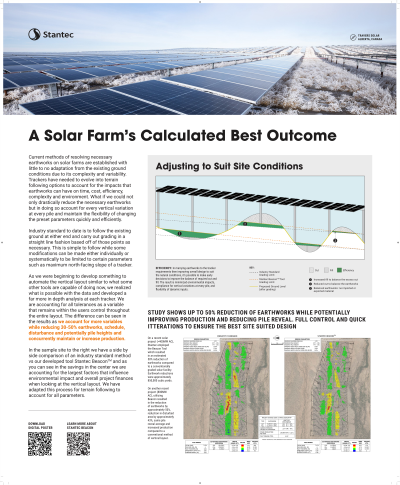Back

Managing Growth
Solar Farm Pile and Grading Optimization
Tuesday, September 12, 2023
4:30 PM - 5:30 PM PDT
Location: Poster Area, Booth #11024, Level 1, Venetian Expo Hall


Kyle D. Jones, CET (he/him/his)
Civil Designer
Stantec
West Chezzetcook, Nova Scotia, Canada
Poster Presenter(s)
Proposal information to include, objective, methods, results, and conclusion: Current methods of resolving necessary earthworks on solar farms are established with little to no optimization due to the complexity and variability in existing ground conditions. Trackers have needed to evolve into terrain following options to account for the impacts that earthworks can have on time, cost, efficiency, complexity and environment. What if we could not only drastically reduce the necessary earthworks but in doing so account for every vertical variation at every pile and maintain the flexibility of changing the preset parameters quickly and efficiently.
In marrying the earthworks to the tracker requirements and then optimizing the overall design to suit the natural conditions, it's possible to make early decisions on steel vs grading requirements, development footprint and overall environmental impacts. We've developed a process of analyzing this to the minute detail while making it adaptable to changes with quick turn arounds.
To date we've applied this process to several solar farms with reductions in earthworks by approx. 50% to prior methods and can ensure compliance to every vertical tolerance applicable. This offers many supplementary benefits such as reduced cost, reduced schedule, reduced environmental impact, improved efficiency and layout knowledge. By having this process available we can obtain expected earthworks at the feasibility stage in a timely manner to make the decisions that count rather than counting on the earthwork to fall within an assumed parameter or overestimating from unseen optimization potential.
The benefits of optimizing a solar farm's vertical layout are numerous and we're able to do so by providing a far more detailed understanding at every pile across a project while giving back the adaptable control to the desired outcome.
In marrying the earthworks to the tracker requirements and then optimizing the overall design to suit the natural conditions, it's possible to make early decisions on steel vs grading requirements, development footprint and overall environmental impacts. We've developed a process of analyzing this to the minute detail while making it adaptable to changes with quick turn arounds.
To date we've applied this process to several solar farms with reductions in earthworks by approx. 50% to prior methods and can ensure compliance to every vertical tolerance applicable. This offers many supplementary benefits such as reduced cost, reduced schedule, reduced environmental impact, improved efficiency and layout knowledge. By having this process available we can obtain expected earthworks at the feasibility stage in a timely manner to make the decisions that count rather than counting on the earthwork to fall within an assumed parameter or overestimating from unseen optimization potential.
The benefits of optimizing a solar farm's vertical layout are numerous and we're able to do so by providing a far more detailed understanding at every pile across a project while giving back the adaptable control to the desired outcome.
